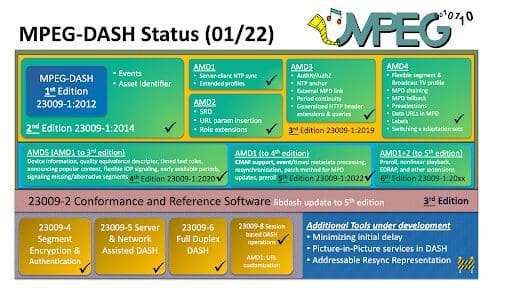Preface
Bitmovin isn’t the only organization whose sole purpose is to shape the future of video – a few senior developers at Bitmovin along with me are active members of the Moving Pictures Expert Group (MPEG). Personally, I have been a member and attendant of MPEG for 15+ years and have been documenting the progress since early 2010. Today, we’re working hard to further improve the capabilities and efficiency of the industry’s newest standards, such as VVC, LCEVC, and MIV.
The 137th MPEG Meeting – Immersive Experiences Move Forward
It’s been a long six months of research and progression in the world of video standards-setting – as MPEG (and Bitmovin alike) have had their heads down to run new efficiency experiments to improve codecs such as VVC/h.266 in collaboration with Fraunhofer HHI, I haven’t had the chance to publish one of my quarterly meeting reports for the 136th MPEG meeting. So, this month’s report will cover both the 136th and 137th MPEG Meetings. The latest developments in the standards space have expectedly been focused around improvements to VVC & LCEVC, however, what’s progressing fast than usual are technologies that focus in on both audio & visual immersive experiences.
I’ve addressed most of the recent updates in the official press release of the 137th MPEG meeting can be found here and comprises the following items:
-
- MPEG Systems Wins Two More Technology & Engineering Emmy® Awards
- MPEG Audio Coding selects 6DoF Technology for MPEG-I Immersive Audio
- MPEG Requirements issues Call for Proposals for Encoder and Packager Synchronization
- MPEG Systems promotes MPEG-I Scene Description to the Final Stage
- MPEG Systems promotes Smart Contracts for Media to the Final Stage
- MPEG Systems further enhanced the ISOBMFF Standard
- MPEG Video Coding completes Conformance and Reference Software for LCEVC
- MPEG Video Coding issues Committee Draft of Conformance and Reference Software for MPEG Immersive Video
- JVET produces Second Editions of VVC & VSEI and finalizes VVC Reference Software
- JVET promotes Tenth Edition of AVC to Final Draft International Standard
- JVET extends HEVC for High-Capability Applications up to 16K and Beyond
- MPEG Genomic Coding evaluated Responses on New Advanced Genomics Features and Technologies
- MPEG White Papers
- Neural Network Coding (NNC)
- Low Complexity Enhancement Video Coding (LCEVC)
- MPEG Immersive Video
In this report, I’d like to focus on the Emmy® Awards, video coding updates (AVC, HEVC, VVC, and beyond), and a brief update about DASH (as usual).
MPEG Systems Wins Two More Technology & Engineering Emmy® Awards
MPEG Systems is pleased to report that MPEG is being recognized this year by the National Academy for Television Arts and Sciences (NATAS) with two Technology & Engineering Emmy® Awards, for (i) “standardization of font technology for custom downloadable fonts and typography for Web and TV devices and for (ii) “standardization of HTTP encapsulated protocols”, respectively.
The first of these Emmys is related to MPEG’s Open Font Format (ISO/IEC 14496-22) and the second of these Emmys is related to MPEG Dynamic Adaptive Streaming over HTTP (i.e., MPEG DASH, ISO/IEC 23009). The MPEG DASH standard is the only commercially deployed international standard technology for media streaming over HTTP and it is widely used in many products. MPEG developed the first edition of the DASH standard in 2012 in collaboration with 3GPP and since then has produced four more editions amending the core specification by adding new features and extended functionality. Furthermore, MPEG has developed six other standards as additional “parts” of ISO/IEC 23009 enabling the effective use of the MPEG DASH standards with reference software and conformance testing tools, guidelines, and enhancements for additional deployment scenarios. MPEG DASH has dramatically changed the streaming industry by providing a standard that is widely adopted by various consortia such as 3GPP, ATSC, DVB, and HbbTV, and across different sectors. The success of this standard is due to its technical excellence, large participation of the industry in its development, addressing the market needs, and working with all sectors of industry all under ISO/IEC JTC 1/SC 29 MPEG Systems’ standard development practices and leadership.
These are MPEG’s fifth and sixth Technology & Engineering Emmy® Awards (after MPEG-1 and MPEG-2 together with JPEG in 1996, Advanced Video Coding (AVC) in 2008, MPEG-2 Transport Stream in 2013, and ISO Base Media File Format in 2021) and MPEG’s seventh and eighth overall Emmy® Awards (including the Primetime Engineering Emmy® Awards for Advanced Video Coding (AVC) High Profile in 2008 and High-Efficiency Video Coding (HEVC) in 2017).
Bitmovin and its founders have been actively contributing to the MPEG DASH standard since its inception. My initial blog post dates back to 2010 and the first edition of MPEG DASH was published in 2012. A more detailed MPEG DASH timeline provides many pointers to the Institute of Information Technology (ITEC) at the Alpen-Adria-Universität Klagenfurt and its DASH activities that is now continued within the Christian Doppler Laboratory ATHENA. In the end, the MPEG DASH community of contributors to and users of the standards can be very proud of this achievement only after 10 years of the first edition being published. Thus, also happy 10th birthday MPEG DASH and what a nice birthday gift.
Video Coding Updates
In terms of video coding, there have been many updates across various standards’ projects at the 137th MPEG Meeting.
Advanced Video Coding
Starting with Advanced Video Coding (AVC), the 10th edition of Advanced Video Coding (AVC, ISO/IEC 14496-10 | ITU-T H.264) has been promoted to Final Draft International Standard (FDIS) which is the final stage of the standardization process. Beyond various text improvements, this specifies a new SEI message for describing the shutter interval applied during video capture. This can be variable in video cameras, and conveying this information can be valuable for analysis and post-processing of the decoded video.
High-Efficiency Video Coding
The High-Efficiency Video Coding (HEVC, ISO/IEC 23008-2 | ITU-T H.265) standard has been extended to support high-capability applications. It defines new levels and tiers providing support for very high bit rates and video resolutions up to 16K, as well as defining an unconstrained level. This will enable the usage of HEVC in new application domains, including professional, scientific, and medical video sectors.
Versatile Video Coding
The second editions of Versatile Video Coding (VVC, ISO/IEC 23090-3 | ITU-T H.266) and Versatile supplemental enhancement information messages for coded video bitstreams (VSEI, ISO/IEC 23002-7 | ITU-T H.274) have reached FDIS status. The new VVC version defines profiles and levels supporting larger bit depths (up to 16 bits), including some low-level coding tool modifications to obtain improved compression efficiency with high bit-depth video at high bit rates. VSEI version 2 adds SEI messages giving additional support for scalability, multi-view, display adaptation, improved stream access, and other use cases. Furthermore, a Committee Draft Amendment (CDAM) for the next amendment of VVC was issued to begin the formal approval process to enable linking VVC with the Green Metadata (ISO/IEC 23001-11) and Video Decoding Interface (ISO/IEC 23090-13) standards and add a new unconstrained level for exceptionally high capability applications such as certain uses in professional, scientific, and medical application scenarios. Finally, the reference software package for VVC (ISO/IEC 23090-16) was also completed with its achievement of FDIS status. Reference software is extremely helpful for developers of VVC devices, helping them in testing their implementations for conformance to the video coding specification.
Beyond VVC
The activities in terms of video coding beyond VVC capabilities, the Enhanced Compression Model (ECM 3.1) performance over VTM-11.0 + JVET-V0056 (i.e., VVC reference software) shows an improvement of close to 15% for Random Access Main 10. This is indeed encouraging and, in general, these activities are currently managed within two exploration experiments (EEs). The first is on neural network-based (NN) video coding technology (EE1) and the second is on enhanced compression beyond VVC capability (EE2). EE1 currently plans to further investigate (i) enhancement filters (loop and post) and (ii) super-resolution (JVET-Y2023). It will further investigate selected NN technologies on top of ECM 4 and the implementation of selected NN technologies in the software library, for platform-independent cross-checking and integerization. Enhanced Compression Model 4 (ECM 4) comprises new elements on MRL for intra, various GPM/affine/MV-coding improvements including TM, adaptive intra MTS, coefficient sign prediction, CCSAO improvements, bug fixes, and encoder improvements (JVET-Y2025). EE2 will investigate intra prediction improvements, inter prediction improvements, improved screen content tools, and improved entropy coding (JVET-Y2024).
Bitmovin Encoding supports AVC and HEVC for many years and currently investigates the integration of VVC. Bitmovin Player is coding format agnostic and utilizes the underlying hardware/software platform for decoding but efficiently handles multi-codec use cases.
The latest MPEG-DASH Update
Finally, I’d like to provide a brief update on MPEG-DASH! At the 137th MPEG meeting, MPEG Systems issued a draft amendment to the core MPEG-DASH specification (i.e., ISO/IEC 23009-1) about Extended Dependent Random Access Point (EDRAP) streaming and other extensions which it will be further discussed during the Ad-hoc Group (AhG) period (please join the dash email list for further details/announcements). Furthermore, Defects under Investigation (DuI) and Technologies under Consideration (TuC) are available here.
An updated overview of DASH standards/features can be found in the Figure below.

The next meeting will be again an online meeting in April 2022.
Click here for more information about MPEG meetings and their developments.
Check out the following links for other great reads!
A little lost about the formats and standards described above? Check out some other great educational content to learn more!




